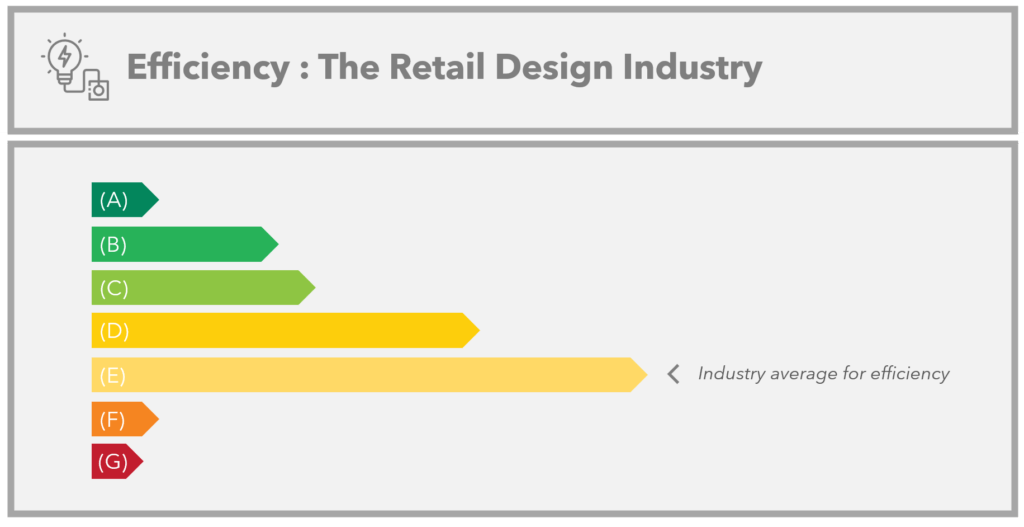‘Sustainability’ is a subject that has pushed it’s way to the forefront of many business decisions over the past decade. Once a ‘nice-to-have’, a commitment to sustainability is now essential ethically, legally[i] and commercially. The retail industry is one of the highest contributors to GHG emissions in the UK and the production of retail display equipment is a contributor to this.[ii] Many businesses are now setting about changing their environmental priorities with vigour. Making the commitment to net zero emissions is the easy bit, however; how do we go about accurately measuring, monitoring and proving progression?
Assessing how sustainable a product is can be tricky, often subject to lengthy discussions and concluded with opinions and averages. To give precise, comparable results, we need to be able to produce consistent, precise data and over the past few years, sustainability specialists, Design Conformity, have been developing a certification process for the retail design industry to do just this. The independent specialist team has worked alongside Dr. Leigh Holloway and Bill Jones who, between them, have nearly 50 years of experience working in the field of sustainable design.
Over his career, Dr. Leigh Holloway has had extensive experience using (and creating) a wide range of methods to measure the environmental impact of products, particularly within the retail design sector. Leigh said of his own experience:-
“What’s become apparent to me, is that trying to compare products and materials that have had their sustainability calculated in different ways is not ideal.”
Having experienced this problem first-hand, Leigh was enthusiastic to work with Design Conformity to find a solution:
“Processes like the dc certification address this issue by ensuring a consistent approach and result in more robust and valid impact assessments. It’s something that I think will bring real benefits to the sector and was keen to be involved.”
So how exactly do you measure sustainability? Environmental sustainability covers a broad spectrum of factors and issues, reflecting this, the dc certification assesses the complete design process and intended life of the display. The analysis covers 3 key categories: Environmental Impact, Design Circularity and Energy Efficiency, giving a score for each. The evaluation aligns with The Carbon Trust’s Green House Gas Protocol and enables production of a measured, exacting, evidence-based report on the sustainability of each design.

To establish an industry average, dc has assessed the efficiency of over 250 designs, producing unprecedented insights into the current sustainability performance within the industry. The rating for Efficiency is scored from A – F (with A being most efficient); the study found that over 40% of the designs assessed fell into the ‘E’ rated category. Using the data produced to pinpoint opportunities for improvement and utilising the dc Retail Design Guide, designers have typically been able to increase the efficiency of a display by more than 50%. By improving their score, brands are not only reducing energy wastage and carbon emissions but also cutting operating costs. The Retail Design Guide will soon be made available to access for all, with the launch of the new Design Conformity website.

Design Conformity has committed to supporting brands and designers in their dedication to improving the sustainability of the UK’s retail industry, throughout the supply chain. Founder, Adam Hamilton-Fletcher explained his motivation to create the dc specification and certification process:
“We created the dc design standard to provide manufactures with an independent certification for safe, sustainable design. I’m really proud that with the support of our dc Specialists and approved suppliers we’re helping the industry to become more innovative and sustainable.”
Environmental specialist, Bill Jones agreed:
“Over the last 15 years there has been an increasing need to establish better design and work practices and I believe the dc certification can be instrumental in supporting our client’s environmental objectives.”
If you would like to know more about the Design Conformity certification and the sustainability rating process, get in touch at info@localhost To see updates on Design Conformity’s research within the industry and company announcements, follow on LinkedIn https://www.linkedin.com/company/callow-partners
[i] https://www.legislation.gov.uk/ukpga/2008/27/pdfs/ukpga_20080027_en.pdf
[ii] https://brc.org.uk/climate-roadmap/section-1-context/15-the-uk-retail-industry-and-climate-change/






